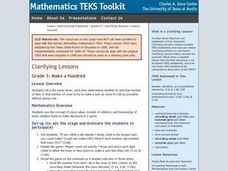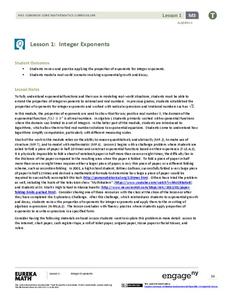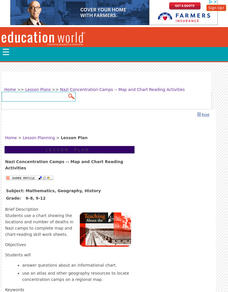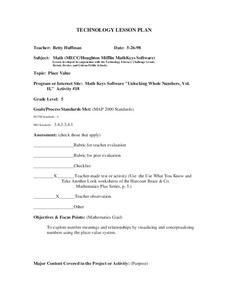National Security Agency
Place Value - Butterflies Floating Place to Place
Learn about butterflies and place value in a series of interdisciplinary lessons! With several worksheets that reference butterfly facts in word problems, kids can practice science and math in one activity. Additional worksheets are...
Alabama Learning Exchange
Miss Integer Finds Her Properties in Order
Access prior knowledge to practice concepts like order of operations and exponents. Your class can play this game as a daily review or as a warm-up activity when needed. They work in groups of four to complete and correct review problems.
Alabama Learning Exchange
Ice Fishing is for the Birds
Approach addition with young mathematicians in an engaging way through this penguin-inspired activity. In small groups, scholars think about times they have used addition in their real lives (there are some suggestions given), then watch...
Curated OER
Lots of Lakes: Greater Than, Less Than
To set up this activity, your class explores Minnesota's nickname as the Land of 10,000 Lakes, and the back of the state quarter that features a Minnesota lake. Young mathematicians compare the number 1 to the number 10,000 with support...
Curated OER
Grade 3: Make a Hundred
Third graders roll a die seven times, each time determining whether to add that number of tens or that number of ones to try to make a sum as close to 100 as possible without going over.
Curated OER
What's on Sale?
Students explore sale items. In this money and percent math lesson, students work in groups to locate food ads in the newspaper. Students identify sales and calculate final prices using percentage discounts. Students...
Curated OER
Compatible Numbers To Ten
Students solve both addition and subtraction facts and discover the relationship between adding and subtracting equations. Students read real life word problems, extrapolate needed information, and write equations to solve the story...
EngageNY
Integer Exponents
Fold, fold, and fold some more. In the first installment of a 35-part module, young mathematicians fold a piece of paper in half until it can not be folded any more. They use the results of this activity to develop functions for the area...
Illustrative Mathematics
Sort and Count II
Capture the engagement of young mathematicians with this hands-on sorting activity. Given a bag of objects, students work independently sorting the items based on their physical attributes, counting to determine the size of each group....
Space Awareness
History of the Universe
Your pupils may believe that you and their parents are the oldest things in the universe, but surprise! There are elements of the universe that are even older. Elementary scientists create a class timeline to demonstrate the...
EngageNY
Analyzing Residuals (Part 1)
Just how far off is the least squares line? Using a graphing calculator, individuals or pairs create residual plots in order to determine how well a best fit line models data. Three examples walk through the calculator procedure of...
Kenan Fellows
Installing and Working with R Statistical Software
Save download time—install software now in preparation for future lessons. The R statistical software is a free program used by the Federal Reserve Bank and many companies. Bring the power of the software to your classroom to use in the...
Curated OER
Two-Dimensional Geometric Shapes
Students participate in hands-on activities to explore the shapes in their environment.
Curated OER
Nazi Concentration Camps -- Map and Chart-Reading Activities
Students use an informational chart about Nazi concentration and death camps to complete a mapping activity and a chart-reading activity.
Curated OER
Food Math
Fourth graders explore healthy habits by completing caloric measurement activities. In this food choice lesson, 4th graders discuss what types of foods give you protein or fat and utilize a food chart to measure caloric intake. Students...
Curated OER
Building Tolerance for Poverty in Math
Students explore approximate and exact solutions. In this interdisciplinary instructional activity, 6th graders will be placed in 'family groups' to create a budget that is subject to random events as chosen from the 'things happen' box....
Curated OER
Hypothesis Testing: Two Sample Tests
Students experiment and compare results of two populations. In this men and women populations lesson plan, students examine the difference in hand span for men and women. Students calculate a norm based on their...
Curated OER
MathKeys Software "Unlocking Whole Numbers, Vol. 11(Place Value for Four Digit Numbers)"
Third graders explore the place values of four digit numbers by writing four digit numbers and examining the effects of rearranging the numbers' digits. They practice making their four digit number with base-ten blocks then rearrange the...
Curated OER
Place Value
Fifth graders explore number meanings and their relationship. Using place value clues and base-ten blocks, 5th graders build a models of numbers and determine their value. To reinforce number relationship, students participate in a...
Curated OER
Building Numbers
Fifth graders use place value clues to find a given number. In this place value instructional activity, 5th graders work with the MathKeys program using place value clues and base-ten blocks to build a number and determine its value.
Curated OER
One- and Two-Digit Multiplication
Third graders multiply whole numbers by one- and two-digit numbers using base ten blocks and technology connection.
Curated OER
Everyone's Playing Basketball
To foster number sense and build problem solving skills, pupils will work through a complex word problem. They will be asked to analyze the data given, solve the problem, then share their thinking process with the class. This activity...
Curated OER
Tell Us All: Tools for Integrating Math and Engineering
What a scam! Middle and high schoolers pose as journalists exposing consumer fraud. In this lesson, they write an article for a magazine using data collected during previous investigations (prior lessons) to defend their findings that a...
Curated OER
Math Wars!
Pupils name numbers from 1-10, complete basic addition, or basic multiplication based on their grade. In this math card game lesson, students use a deck of cards to improve their math skills based on their grade.






















